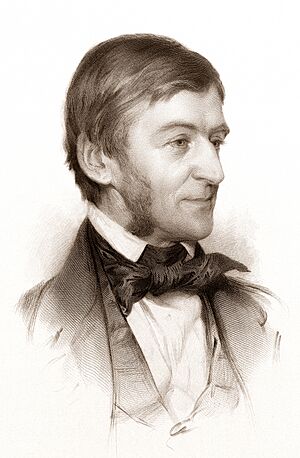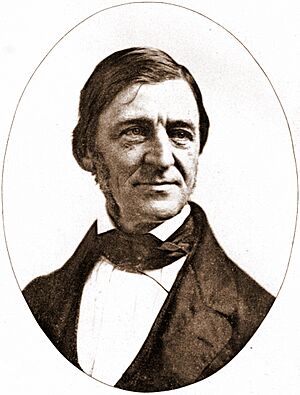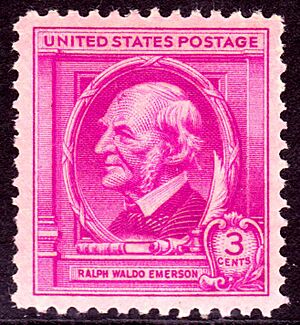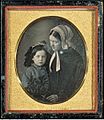Ralph Waldo Emerson facts for kids
Quick facts for kids
Ralph Waldo Emerson
|
|
|---|---|
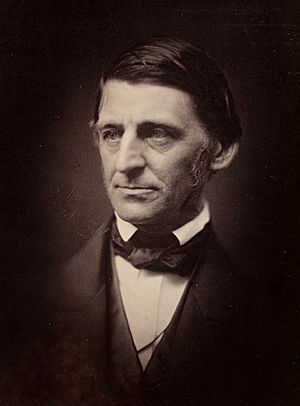
A photo of Ralph Waldo Emerson from around 1857.
|
|
| Born | May 25, 1803 Boston, Massachusetts, U.S.
|
| Died | April 27, 1882 (aged 78) Concord, Massachusetts, U.S.
|
| Alma mater | Harvard Divinity School |
| Spouse(s) |
Ellen Louisa Tucker
(m. 1829; died 1831) |
| Era | 1800s philosophy |
| Region | American philosophy |
| School | Transcendentalism |
| Institutions | Harvard College |
|
Main interests
|
Individualism, nature, God, cultural criticism |
|
Notable ideas
|
Self-reliance, transparent eyeball, double consciousness |
|
Influences
|
|
| Signature | |
 |
|
Ralph Waldo Emerson (born May 25, 1803 – died April 27, 1882) was an important American writer, speaker, and thinker. He was known by his middle name, Waldo. He led a movement called Transcendentalism in the mid-1800s.
Emerson believed strongly in individualism, meaning that each person is unique and important. He also spoke out against society's pressures that try to make everyone the same. He shared his ideas through many essays and over 1,500 public talks across the United States.
He slowly moved away from the common religious beliefs of his time. He developed his philosophy of transcendentalism in his 1836 essay called "Nature". After this, he gave a famous speech in 1837 called "The American Scholar". Many people, including writer Oliver Wendell Holmes Sr., called it America's "intellectual Declaration of Independence."
Emerson often wrote his important essays first as lectures. Then he would change them for printing. His first two collections of essays, Essays: First Series (1841) and Essays: Second Series (1844), show his main ideas. These books include famous essays like "Self-Reliance" and "Experience." These years, from the mid-1830s to the mid-1840s, were his most creative time.
Emerson wrote about many topics. He believed in individuality, freedom, and the amazing ability of people to achieve almost anything. He also explored the connection between a person's soul and the world around them. Emerson saw nature as more than just trees and animals; he saw it as connected to the soul. He believed that God is not separate from the world but is part of everything.
Emerson is a key figure in American romanticism. His work greatly influenced many writers and thinkers who came after him. He once wrote that in all his talks, he taught one main idea: "the infinitude of the private man," meaning every person has endless potential. He was also a close friend and mentor to Henry David Thoreau, another famous transcendentalist.
Contents
Early Life and Education
Emerson was born in Boston, Massachusetts, on May 25, 1803. His father, William Emerson, was a Unitarian minister. Ralph Waldo was the second of five sons who grew up.
His father died when Emerson was almost eight years old. His mother raised him with help from other women in the family. His aunt, Mary Moody Emerson, was especially important to him. She lived with the family sometimes and wrote letters to Emerson throughout her life.
Emerson started formal school at the Boston Latin School in 1812. In 1817, at age 14, he went to Harvard College. He took on small jobs to pay for school, like being a waiter. During his junior year, he started keeping a journal, which he called "Wide World." By his senior year, he decided to go by his middle name, Waldo. He graduated from Harvard in 1821, when he was 18.
In the early 1820s, Emerson taught at a school for young ladies. He then spent two years living in a cabin in Roxbury, Massachusetts. There, he wrote and studied nature. This area is now called Schoolmaster Hill in Boston's Franklin Park.
In 1826, because of poor health, Emerson traveled south for a warmer climate. He went to Charleston, South Carolina, and then to St. Augustine, Florida. In Florida, he walked on the beach and started writing poetry. He met Prince Achille Murat, who was Napoleon Bonaparte's nephew. They became good friends and talked a lot about religion, society, and philosophy. Emerson felt Murat helped him grow intellectually.
While in St. Augustine, Emerson saw slavery for the first time. He once attended a church meeting while a slave auction was happening outside. He wrote about hearing both "glad tidings of great joy" and "Going, gentlemen, going!" at the same time.
Early Career and Travels
After Harvard, Emerson helped his brother William run a school for young women. In late 1824, Emerson was accepted into the Harvard Divinity School. Sadly, two of his younger brothers, Edward and Charles, died young from illness in the 1830s.
Emerson met his first wife, Ellen Louisa Tucker, in 1827. They married two years later when she was 18. Ellen was already sick with tuberculosis. She died less than two years later, in 1831, at age 20. Emerson was deeply saddened by her death.
In 1829, Emerson became a junior pastor at Boston's Second Church. He also served as a chaplain for the Massachusetts government. However, after his wife's death, he began to question his religious beliefs. He felt that the church's old ways were not right for him anymore. In 1832, he resigned from his role as pastor. He felt that leaving the church would allow him to be a better teacher and thinker, free from strict rules.
In 1833, Emerson traveled through Europe. He wrote about his trip later in a book called English Traits (1856). He visited Italy, Switzerland, and France. In Paris, he was very impressed by the Jardin des Plantes, a botanical garden. He saw how all plants were connected and organized. This experience helped him think more about science and less about traditional theology.
In England, Emerson met famous writers like William Wordsworth, Samuel Taylor Coleridge, and Thomas Carlyle. Carlyle became a strong influence on him. Emerson helped Carlyle publish his books in the United States. They wrote letters to each other for many years.
Emerson returned to the United States in 1833. He soon saw a chance to become a lecturer, as public talks were very popular. On November 5, 1833, he gave his first lecture in Boston. This was the start of his long career as a public speaker.
In 1835, Emerson bought a house in Concord, Massachusetts, which is now the Ralph Waldo Emerson House. He quickly became an important person in the town. He married Lydia Jackson in September 1835. They had four children: Waldo, Ellen, Edith, and Edward. Ellen was named after his first wife.
Emerson was not rich when he was at Harvard. But he later inherited money from his first wife's family. This money, along with his earnings from lecturing, helped him support his family. He earned a good living from his talks.
Literary Career and Transcendentalism
In 1836, Emerson's first essay, "Nature," was published. Around the same time, he met with other thinkers to plan regular meetings. This was the beginning of the Transcendental Club. This group became the center for the Transcendentalism movement. They discussed new ideas about spirituality, nature, and individual freedom.
In 1837, Emerson gave his famous "The American Scholar" speech at Harvard. In this speech, he told Americans to create their own unique writing style, free from European influences. Many people praised the speech, calling it a major moment in American literature.
Emerson became friends with Henry David Thoreau in 1837. Emerson's question, "Do you keep a journal?", inspired Thoreau to write his own famous journals. Emerson's own journals, published in many volumes, are considered a very important part of his work.
Emerson's career as a lecturer grew. He often gave as many as 80 lectures a year, traveling across the country. He spoke on many different topics, and many of his essays came from these talks. He earned a good income from his lectures.
In 1838, Emerson gave the "Divinity School Address" at Harvard. In this speech, he suggested that people could experience truth directly from nature, rather than only through traditional religion. He said that Jesus was a great man, but not God in the way some believed. These ideas upset many religious leaders, and he was not invited back to Harvard for 30 years.
In 1840, the Transcendental Club started its own journal called The Dial. Margaret Fuller was the first editor, and Emerson later took over. The journal helped promote new writers like Thoreau.
In 1841, Emerson published Essays, which included his famous essay "Self-Reliance". This essay encouraged people to trust their own thoughts and instincts. The book was well-received and helped him become famous internationally.
In January 1842, Emerson's first son, Waldo, died from scarlet fever. Emerson wrote about his deep sadness in a poem called "Threnody" and in the essay "Experience."
In 1843, some transcendentalists, inspired by Emerson's ideas, started a community called Fruitlands. They wanted to live simply, without using animals for labor or eating meat. Emerson supported their ideas but felt it would be hard to make it work. The community eventually failed, as it was difficult to live out their ideals in practice.
Emerson continued to write and lecture. In 1844, he published Essays: Second Series. He also became interested in Indian philosophy, reading works like the Bhagavad Gita. He learned that the purpose of life was spiritual growth and experiencing divine power in the present moment.
In 1847–48, he traveled to the British Isles and Paris. He saw the effects of the French Revolution of 1848. His observations from this trip were used in his 1856 book English Traits.
In 1852, Emerson helped edit the works and letters of Margaret Fuller, who had died in 1850. In 1855, Walt Whitman sent Emerson a copy of his new poetry book, Leaves of Grass. Emerson praised the book, which helped Whitman gain attention.
Philosophers Camp in the Adirondacks
In the summer of 1858, Ralph Waldo Emerson went on a camping trip to the wilderness of upstate New York. He was joined by nine other famous thinkers and writers. This group included Louis Agassiz and James Russell Lowell. They wanted to connect with nature.
This trip became known as the "Philosophers Camp." News spread across the country that these educated men were living like "Sacs and Sioux" in the wild. This event was important because it linked nature with art and literature in the 1800s.
Emerson wrote a long poem called "Adirondac" about this trip. It describes his adventures in the wilderness. He had written in his 1836 essay "Nature" that "in the wilderness I find something more dear and connate than in streets or villages." This camping trip brought him face-to-face with the true wilderness he often wrote about.
Civil War Years
Emerson strongly opposed slavery. At first, he was hesitant to speak publicly about it. But from 1844 on, he became more active against slavery. He gave many speeches and welcomed the anti-slavery leader John Brown to his home.
In 1860, Emerson voted for Abraham Lincoln. He was disappointed that Lincoln seemed more focused on keeping the country together than ending slavery right away. Once the American Civil War began, Emerson made it clear he believed slaves should be freed immediately.
In 1860, Emerson published The Conduct of Life, another collection of essays. In these essays, he wrote about the idea of war as a way for a nation to be reborn. He believed that big changes, even difficult ones like war, could lead to progress.
In 1862, Emerson visited Washington, D.C. He gave a public lecture where he said, "Emancipation is the demand of civilization." He also met President Lincoln at the White House. Emerson's doubts about Lincoln lessened after this meeting. In 1865, he spoke at a memorial service for Lincoln, saying that Lincoln's death caused great pain.
On May 6, 1862, Emerson's friend and student, Henry David Thoreau, died. Emerson gave the speech at his funeral. Another friend, Nathaniel Hawthorne, died two years later in 1864. Emerson was a pallbearer at Hawthorne's burial.
Later Years and Death
Starting in 1867, Emerson's health began to decline. He wrote less in his journals. By the early 1870s, he started having memory problems and trouble finding words. He sometimes forgot his own name.
In 1871, Emerson took a trip on the transcontinental railroad to California. He visited Yosemite and met a young John Muir, who later became a famous naturalist.
Emerson's home in Concord caught fire on July 24, 1872. Neighbors helped save many of his belongings. Friends collected money to help him rebuild his house. While his house was being rebuilt, Emerson traveled to England, Europe, and Egypt with his daughter Ellen. When he returned to Concord in 1873, the town celebrated his return. After the fire, Emerson mostly stopped giving public lectures, speaking only on special occasions.
In late 1874, Emerson published a collection of poetry called Parnassus. By 1879, his memory problems became too difficult for public appearances. He wrote that old age had "tied my tongue, and hid my memory."
Ralph Waldo Emerson died on April 27, 1882, from pneumonia. He is buried in Sleepy Hollow Cemetery in Concord, Massachusetts.
Beliefs and Legacy
Emerson's religious views were quite new for his time. He believed that everything is connected to God and is therefore divine. He thought that truth could be felt directly from nature, not just learned from religious texts. He once said, "I am more of a Quaker than anything else. I believe in the 'still, small voice', and that voice is Christ within us."
Emerson supported community libraries. He said that a good library holds "a company of the wisest and wittiest men... who have set in best order the results of their learning and wisdom."
Views on Race and Slavery
Emerson became a strong opponent of slavery in 1844. His journals show he was concerned about slavery even when he was young. After a senator who opposed slavery was attacked in 1856, Emerson began to speak out more. He said, "I think we must get rid of slavery, or we must get rid of freedom." He saw slavery as a great injustice.
Emerson believed that slavery should be ended through the democratic process. While he was against slavery, his views on race were complex. Like many people of his time, he sometimes thought that different races had different abilities. In his early life, he was quieter on the topic of race. He started writing about it in his 30s and became known as an anti-slavery activist in his late 40s and 50s.
Early on, Emerson seemed to believe in a hierarchy of races. He wondered if African slaves had the same ability to reason as white men. He wrote in 1822 that some black men seemed to have less "sagacity" than animals. However, he also wrote that "No ingenious sophistry can ever reconcile the unperverted mind to the pardon of Slavery." He saw the forced removal of people from their homes and the treatment of slaves as deeply wrong. For Emerson, slavery was a moral issue.
Emerson saw himself as being of "Saxon descent" (English ancestry). He believed that native-born white Americans of English background were superior to other groups, including European immigrants. His idea of race was linked to shared culture, environment, and history.
Later in his life, Emerson's ideas about race changed as he became more involved in the abolitionist movement. He began to think about the future of racial groups in America. He believed that different European races would eventually mix in America. This mixing, he thought, would lead to a stronger, superior American race.
Legacy
As a speaker, Emerson became a leading voice of intellectual culture in the United States. He was nicknamed the "Sage of Concord." Many people, like editor James Russell Lowell, called him the "most steadily attractive lecturer in America."
Emerson's work influenced many people during his time and continues to influence thinkers and writers today. Famous people like Walt Whitman, Henry David Thoreau, and Nietzsche were all influenced by him. Many agree that Emerson was the most important American writer of the 1800s.
The writer Harold Bloom called Emerson "The prophet of the American Religion." This refers to new American religions that started around Emerson's time. Bloom also compared Emerson to the French writer Michel de Montaigne, saying that reading Emerson's journals is a similar experience to reading Montaigne's works.
Namesakes
- Harvard Divinity School created the Emerson Unitarian Universalist Association Professorship in his honor. Harvard also has a building named Emerson Hall.
- The Emerson String Quartet, a music group formed in 1976, is named after him.
- The Ralph Waldo Emerson Prize is given to high school students for essays on history.
- The Emerson Collective is a company that works for social change.
Selected Works
Collections
- Essays: First Series (1841)
- Essays: Second Series (1844)
- Poems (1847)
- Nature, Addresses and Lectures (1849)
- Representative Men (1850)
- English Traits (1856)
- The Conduct of Life (1860)
- May-Day and Other Pieces (1867)
Individual Essays
- "Nature" (1836)
- "Self-Reliance" (from Essays: First Series)
- "The Over-Soul" (from First Series)
- "Circles" (from First Series)
- "The Poet" (from Essays: Second Series)
- "Experience" (from Essays: Second Series)
- "The American Scholar"
Poems
- "Concord Hymn"
- "The Rhodora"
- "Brahma"
Images for kids
See also
 In Spanish: Ralph Waldo Emerson para niños
In Spanish: Ralph Waldo Emerson para niños


